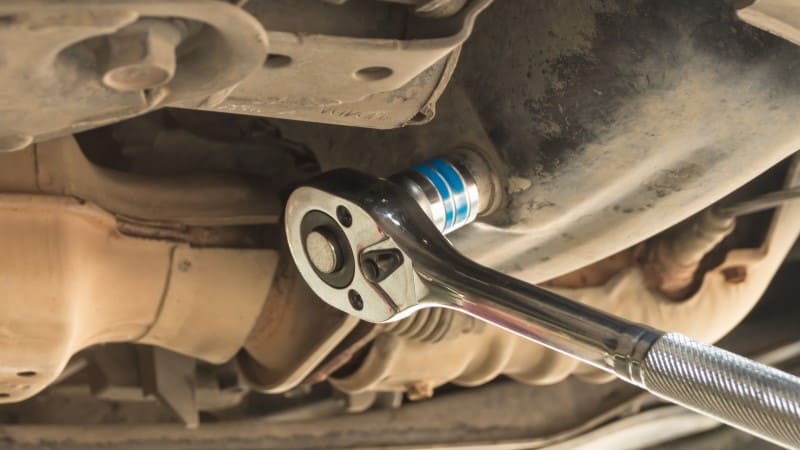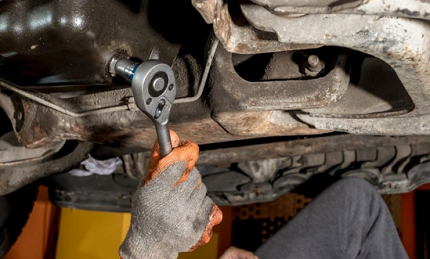To remove an over tightened oil plug, first, you will need to use a wrench or socket that is suitable for the plug size. Apply steady pressure while turning counterclockwise until the plug starts to loosen.
Have you ever found yourself in a frustrating situation where you over tightened the oil plug on your vehicle? Don’t worry, it happens to the best of us. Over tightening the oil plug can pose a significant issue, as it can become difficult to remove without causing further damage.
However, with the right tools and techniques, you can resolve this problem quickly and efficiently. We will guide you through the process of removing an over tightened oil plug, ensuring a smooth and hassle-free experience. So, let’s get started and learn how to tackle this predicament with ease.
Credit: beminimalist.co
The Consequences Of An Over Tightened Oil Plug
The consequences of an over tightened oil plug can lead to significant damage to the oil pan, stripped threads, and difficulty in future oil changes. When the oil plug is excessively tightened, it can cause the oil pan to crack or become damaged, resulting in oil leakage and potential engine damage. Additionally, the excessive force can strip the threads of the oil plug or the oil pan, making it challenging to remove the plug during future oil changes.
Importance of Regular Oil Changes
Importance of Regular Oil Changes
Regular oil changes are essential for maintaining the health and performance of your vehicle. By removing an over tightened oil plug, you can avoid potential engine damage and extend the life of your engine. With regular oil changes, your engine is supplied with clean, fresh oil that lubricates the moving parts, reducing friction and preventing wear and tear.
An over tightened oil plug can lead to stripped threads or a cracked oil pan, which can cause leaks and potential engine failure. By addressing this issue promptly, you can prevent costly repairs and ensure your engine continues to run smoothly.
Regular oil changes also contribute to improved fuel economy. Fresh oil helps to keep the engine clean and free from sludge, improving efficiency and reducing fuel consumption. By investing in regular oil changes, you can save money on fuel in the long run.

To summarize, removing an over tightened oil plug is crucial for maintaining a healthy engine and preventing future damage. Regular oil changes are the key to ensuring your engine’s longevity and efficiency, so it’s important to stay on top of this routine maintenance task.
Socket Wrench With Extension
Socket Wrench with Extension
Choosing the Right Size:
When removing an over tightened oil plug, using a socket wrench with an extension is essential. Choosing the right size of the socket wrench and extension is crucial for successful removal.
The size of the socket wrench should match the size of the oil plug. It is important to measure the width of the oil plug before selecting the socket wrench. The wrong size socket wrench may not fit properly, resulting in ineffective removal of the over tightened plug.
In addition, using an extension is recommended to gain better access and leverage when removing the oil plug. An extension allows for easier application of force, making it easier to turn and loosen the plug.
Importance of Extension:
An extension is particularly useful when the oil plug is located in a hard-to-reach area. It helps to extend the reach of the socket wrench, allowing for improved maneuverability.
Overall, selecting the right size of socket wrench and utilizing an extension properly are crucial steps to successfully removing an over tightened oil plug, ensuring smooth and hassle-free maintenance of your vehicle.
Breaker Bar For Added Leverage
Removing an over tightened oil plug can be a challenging task, but with the right tools, it becomes a lot easier. A breaker bar is one such tool that can provide added leverage to help loosen stubborn oil plugs. Using a breaker bar offers several benefits.
Firstly, its long handle allows for increased torque, making it easier to apply more force. This can be particularly helpful when dealing with over tightened plugs that are difficult to budge.
Secondly, breaker bars come in different sizes, and selecting the correct size is important for optimal performance. It is essential to choose a breaker bar that matches the oil plug size to avoid any damage or slippage during the removal process.
By following these guidelines and using a breaker bar of the appropriate size, you can effectively remove an over tightened oil plug without much hassle.
Oil Drain Plug Removal Tool
When it comes to removing an over tightened oil plug, using an oil drain plug removal tool can be extremely helpful. This tool is specifically designed to remove stuck or tight oil drain plugs without causing any damage to the plug or the oil pan.
The purpose of an oil drain plug removal tool is to provide extra leverage and grip while loosening the plug. It eliminates the need for excessive force or using makeshift tools that can result in stripped threads or rounded bolt heads.
When choosing a removal tool, there are a few features to look for. Firstly, ensure that the tool is made of high-quality materials like hardened steel to withstand the pressure and torque. It should also have a comfortable grip to prevent any slipping or injuries during use.
Additionally, consider the size compatibility of the tool with your specific oil drain plug. Some tools come with adjustable jaws or multiple socket sizes to accommodate different plug sizes. This versatility can save you time and money.
In conclusion, investing in a reliable oil drain plug removal tool is a wise decision for anyone who frequently performs oil changes or deals with over tightened plugs. With the right tool, you can easily and safely remove stuck plugs, preventing any potential damage to your vehicle.
Step 1: Preparing The Vehicle
To ensure a smooth and safe process of removing an over tightened oil plug, it is crucial to take appropriate safety measures and locate the oil drain plug correctly.
Ensuring Safety Measures
- Before starting any work, make sure the vehicle is parked on a level surface to prevent it from rolling or tipping.
- Turn off the engine and allow it to cool for a sufficient amount of time to avoid any potential burns from hot oil.
- Wear protective gloves and safety glasses to shield your hands and eyes from any potential hazards.
Identifying The Oil Drain Plug Location
Start by consulting the vehicle’s owner manual to find the exact location of the oil drain plug, as it can vary depending on the make and model of the car. Generally, it is located on the bottom side of the engine oil pan. Ensure that you have clear access to the plug to perform the subsequent steps properly.
Step 2: Loosening The Plug
In Step 2 of removing an over tightened oil plug, you will need to apply penetrating oil to help loosen the plug. To do this, you will need a socket wrench and a breaker bar. Begin by attaching the socket wrench to the breaker bar and selecting the appropriate socket size for your oil plug. Make sure the breaker bar is securely attached to the socket wrench.
Next, locate the oil plug underneath your vehicle’s engine. Position the socket wrench onto the plug and align it so that it is perpendicular to the ground. Apply steady pressure in a counterclockwise direction to begin loosening the plug. If the plug is stubborn and doesn’t move, apply penetrating oil to the area around the plug. This will help to break up any rust or debris that may be causing the plug to be stuck.
Allow the penetrating oil to soak for a few minutes, and then attempt to loosen the plug again using the socket wrench and breaker bar. Apply firm but controlled force to avoid damaging the plug or surrounding area. Repeat this process until the plug starts to loosen, and then continue on to Step 3 of removing the over tightened oil plug.
Step 3: Removing The Plug
Here are the steps to remove an over tightened oil plug:
- Step 1: Assess the Situation
- Check if you have the necessary tools: a drain pan, gloves, and an oil drain plug removal tool.
- Inspect the plug for any signs of stripping or damage.
- Step 2: Prepare
- Ensure the engine is cool and the vehicle is on a level surface.
- Position the drain pan directly below the oil plug to catch any oil spills.
- Step 3: Removing the Plug
- Using the oil drain plug removal tool, place it over the plug.
- Turn the tool counterclockwise with steady pressure.
- If the plug is still too tight, apply penetrating oil to help loosen it.
- Step 4: Replace or Repair
- If the plug is damaged, replace it with a new one.
- If it’s just over tightened, clean the threads and reinstall it carefully.
- Step 5: Refill and Check
- Fill the engine with the appropriate amount of fresh oil.
- Start the engine and check for any leaks.
By following these steps, you can successfully remove an over tightened oil plug without causing further damage to your vehicle.
Applying Heat To Loosen The Plug
When attempting to remove an over tightened oil plug, using heat can be an effective method. This can help to loosen the plug and make it easier to unscrew. One way to apply heat is by using a heat gun or a blow dryer.
Pointing the heat source towards the oil plug for a few minutes can expand the metal and break the initial seal. It is important to remember to exercise caution when using a heat gun or blow dryer. Keep the heat source at a safe distance to prevent any damage or accidents.
Additionally, it is crucial to protect your hands and other sensitive areas from the heat. Wearing heat-resistant gloves and using heat-resistant materials such as a heat-resistant mat can help minimize the risk of burns or injuries.
By taking these precautions and applying heat correctly, you can increase your chances of successfully removing an over tightened oil plug.
Tapping The Plug To Loosen
When it comes to removing an over tightened oil plug, tapping the plug to loosen it is a common method. This gentle tapping helps to break the seal created by the tight plug. To tap the plug, you can use various methods.
Method 1: Using a rubber mallet or a wooden block.
Method 2: Applying gentle taps with a hammer and a socket extension.
Method 3: Tapping the plug with the help of a wrench.
Remember, caution is crucial when tapping the plug. You need to avoid excessive force as it can lead to damage. Excessive force can result in rounded edges or even cause the plug to break. Take your time and tap the plug gently but consistently to ensure an effective loosening. With patience and the right technique, you can successfully remove an over tightened oil plug without causing any additional issues.
Seeking Professional Help
How to Remove an Over Tightened Oil Plug
When Diy Methods Fail
When dealing with an over tightened oil plug, it can be frustrating and difficult to remove without causing damage. At times, even after trying several DIY methods, the plug may still remain stuck. In such situations, it is beneficial to consult a professional mechanic who has the expertise and experience to tackle this problem effectively.
By seeking professional help, you can:
- Ensure the plug is removed safely without any further complications
- Prevent damaging the oil pan or other engine components
- Receive expert advice on the best course of action
- Save time and effort by entrusting the task to a trained professional
- Minimize the risk of leaks or other issues due to improper removal
Consulting a professional mechanic offers peace of mind and a reliable solution for removing an over tightened oil plug. Don’t hesitate to reach out to an experienced professional when DIY methods fail.
Frequently Asked Questions Of How To Remove An Over Tightened Oil Plug
How Do You Remove An Over Tightened Oil Plug?
To remove an over tightened oil plug, you can try using a wrench with a longer handle for more leverage. Apply heat to the plug with a torch to expand the metal before attempting to loosen it. You can also use a breaker bar or a pipe to increase your leverage and help in loosening the plug.
What Happens If The Oil Plug Is Over Tightened?
If the oil plug is over tightened, it can become difficult to remove during an oil change. This can lead to stripped threads or a damaged oil pan. It is important to take caution and avoid excessive force when tightening the oil plug to prevent these issues.
Can You Use Pliers To Remove An Over Tightened Oil Plug?
While pliers can be used to remove an over tightened oil plug in some cases, it is not recommended. Pliers may not provide enough grip on the plug and can cause damage. It is best to use the appropriate tools such as a wrench, breaker bar, or a specialized oil plug removal tool for safe and effective removal.
What Should You Do If You Can’t Remove An Over Tightened Oil Plug?
If you are unable to remove an over tightened oil plug, it is advisable to seek professional help from a mechanic. They have the expertise and tools required to safely and efficiently remove the plug without causing any damage to the oil pan or other components.
Trying to force it out may result in costly repairs.
Conclusion
After following these steps, you should now be well-equipped to remove an over-tightened oil plug with ease. Remember to start by assessing the situation, gathering the necessary tools, and using the right techniques. By being cautious and patient, you can prevent any further damage to your vehicle and successfully resolve the issue.
So, next time you find yourself facing an over-tightened oil plug, fear not! With these tips, you’ll be able to conquer the task efficiently and effectively. Happy wrenching!


Leave a Reply